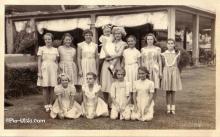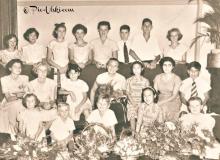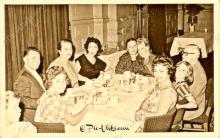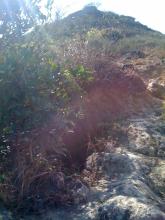Nina SMIRNOFF (née PLESHAKOFF) [????-????]
Primary tabs
Nina Smirnoff (Smirnov) was the wife of Yuri (George) Smirnoff. They married in Harbin and had three children: Irina, Nina and Alexander.
When her husband left for Macao with Irina in late 1943 or early 1944, she stayed behind with the other two chidlren. The family home had been destroyed by a bomb on December 1, 1943 and either with George or after he left she presumably moved to the French Hospital in Causeway Bay, as a Russian friend in Stanley Camp wrote to her at that address in August 1944. She, Nina and Alexander joined George and Irina in Macao at some point, so it's not known if she ever received the letter.
- Nina SMIRNOFF (née PLESHAKOFF) [????-????] spouse of Yuri Vitalievitch SMIRNOFF (aka George) [1903-1947]
- Nina SMIRNOFF (née PLESHAKOFF) [????-????] member of Russian community in Hong Kong [????- ]
- Nina SMIRNOFF (née PLESHAKOFF) [????-????] parent of Irene SMIRNOFF GARFINKLE [????- ]





Comments
Mrs Nina Smirnoff
Hi David
I have a photo of (Mrs) Nina Smirnoff taken at my grandmother's concert at the Pen.
We always had tea or coffee after the piano concerts -- this photo shows the Gabriel family (daughters Laura and Barbara were pupils) and the two ladies on the left hand side were Nina Smirnoff (sitting in the middle) and Ida Close (her husband Samuel Gerzo, HKVDC, died during the Japanese invasion on Christmas Day 1941 and after the war she remarried Joe Close, an English army officer). My grandmother is at the head of the table with another Russian lady but whose name I don't remember :(
Smirnoff home bombed during WW2
The actual date of the first American air raid in Hong Kong which damaged (though did not totally destroy) the Smirnoff home was on the 25th October, 1942. I know because my brother and I were visiting the Smirnoff sisters on that day, and all of us were lucky to escape alive. They lived in a 3 storey apartment building which contained 6 flats in total. The flats were in two parts with just a dividing wall between the two parts of the apartment block. During the air raid, a 500 lb bomb hit the roof of the adjoining section of the block, and went through three floors without exploding. It fell to the bottom floor and landed about 15 feet away from a large crowd who were huddled just on the other side of the dividing wall. I wrote a brief account of that first air raid in the bio section of my website. The URL for that page is: http://atroshenko.com/NSbiog004.html
Paul: many thanks for that
Paul: many thanks for that vivid memory and the link to your excellent blog.
My source was an article in the Hong Kong Sunday Herald, October 28th, 1945, p. 3, based on an interview with Mr Smirnoff, who had returned to Hong Kong on the preceding Friday. The article concludes thus:
By then, of course, Mr. Smirnov (sic) was already in Macao, recuperating from the air raid on the Cameron-Kimberley Road district of Tsimshatsui on December 1, 1943, when he was bombed out of his house.
It looks like he was unlucky enough to be the victim of two bombing raids. I don't know if both were on the same house/apartment block - can you throw any light on that?
Bombing in TST
Hi Brian
Paul and I were discussing the bombing of the Smirnoff house the other week.
My mother told me of a large bomb which dropped in the well of the apartments where my folks lived (3 Cameron Road) and didn't explode. She was home with Lindy (my sister) who was 2-3 years old at the time. She remarked that their guardian angels were working overtime that day
At first I thought the Smirnoffs also lived on Cameron Road but with Paul's help, I discovered they couldn't have!
This photo, taken after my christening in 1947, shows my family and friends outside #3. Our apartment was at the end of Cameron Road, closer to Chatham Road than Nathan Road
Smirnoff Flat
I am trying to upload a simple diagram of the Smirnoff's flat, which I believe was on the corner of Carnarvon and Kimberley Roads. The entrance was similar to the one in Nona's pic of her flat. I suspect that the 500 lb bomb had crashed through the roof and then fell through the stairwell to the ground floor without exploding. A couple of days after that air raid, I sneaked past the Japanese sentries and had a peek at the bomb . It was a scary sight!
. It was a scary sight!
Bombing raids over Kowloon
Looking through Steve's records, his notes for the 25 Oct 1942 raid record the bombs dropped in Kowloon:
RESULTS: Bomb damage is not significant from a military standpoint, though some Japanese military personnel are killed at Whitfield Barracks. Civilians are killed as bombs fall in vicinity of Jordan Road, Austin Road, Cameron Road, and Salisbury Road.
But his notes for the 1 Dec 1943 raid don't mention any civilian casualties:
RESULTS: Bombs hit the Tai Koo and HK & Whampoa dockyards. At Tai Koo, the 2,645-ton Teiren Maru is damaged beyond repair.
And there isn't any mention in the Japanese newspaper's write-up either (copy below). Maybe the reporter who wrote that 1945 article recorded the wrong date for the bombing?
Hi, Nona.
Hi, Nona.
Looks like a number of bombs failed to explode, luckily!
It's a good to know what the buildings we are talking about looked like. When I see photos of people so soon after, I always wonder about their wartime experiences and what they were making of them.
I agree, a mis-dating is
David:
I agree, a mis-dating is possible, especially as being hit on October 25th 1942 would not be surprising, but it seems from Elizabeth Ride's account that the attack on December 1st, 1943, although more significant than the HKN makes out, was focused on the dockyards, and a householder would be unlucky to be 'bombed out' at all, let alone hit for a second time.
On the other hand, the article I cited makes it clear that Mr Smirnoff was in Stanley Prison in 1943, as he met some of the people who were executed on October 29th, and these were all arrested after April 20, 1943. This means he must have stayed in Hong Kong after October 25th 1942, so he was not 'bombed out' of Hong Kong then, although he might have been forced to leave his original dwelling.
I think that this issue can only be resolved by more information.
Early American air raids in Hong Kong (Smirnoff home)
The Japanese were startled by the first American air raids and they did everything they could to minimise the psychological impact on the residents of Hong Kong at that time. I am not surprised that their official reports downplayed the damage done. What did surprise me was that many air raids which occurred much later in the war started well before any alarms were set off by the Japanese. American navy planes would often come over the Peak Tram station on the Peak and sweep down onto the ships in the harbour, long before the air raid sirens would go off. I suspect that the Japanese never really got their act together in terms of spotting enemy aircraft approaching HK.